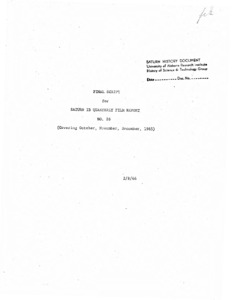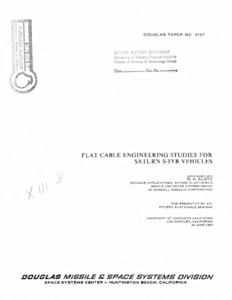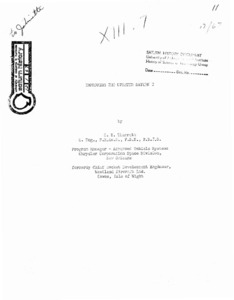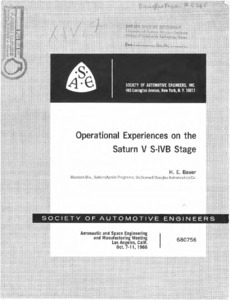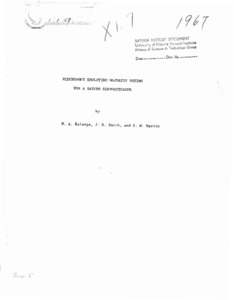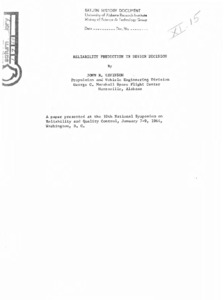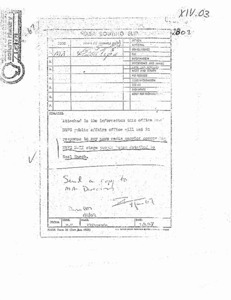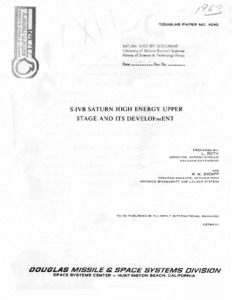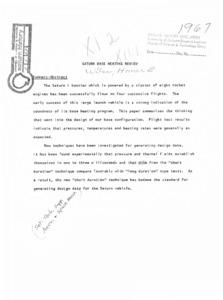
Browse Items (35 total)
Sort by:
-
"Final Script for Saturn IB Quarterly Film Report, No. 26 (covering October, November, December, 1965)."
Film script for the Saturn Quarterly Film Report - October through December, 1965. -
"Flat Cable Engineering Studies for Saturn S-IVB Vehicles."
This paper describes the engineering approaches, investigations, results and conclusions of two National Aeronautics and Space Administration (NASA) flat-cable contracts from the George C. Marshall Space Flight Center (MSFC) to the Douglas Aircraft Company, Inc., for feasibility studies on the S-IVB stage of the Saturn Vehicle. In addition, the objectives and approaches for a third contract., "Flat-Cable Engineering Study", are discussed. A sister Douglas Paper No. 4186, to be presented by Dr. P. L. Hill, covers in detail the manufacturing aspects of the Flat-Cable Development Program.; Prepared by R.A. Klotz, Advance applications, Saturn Electronics, Missile and Space Systems Group, McDonnell Douglas Corporation for presentation at: IPC/EDN Flat-Cable Seminar, University of Southern California, Los Angeles, California, 20 June 1967. -
"Improving the Uprated Saturn I."
This paper discusses five improved versions of the Uprated Saturn I that were studied by the Chrysler Corporation Space Division, supported by the Douglas Aircraft Corporation. -
"Operational Experiences on the Saturn V S-IVB stage."
This paper presents a light, but reverent, discussion of some of the Douglas operational experiences on the Saturn V/S-IVB stage. Certain relevant aspects of earlier work on the Thor intermediate range ballistic missile, the Saturn I S-IV stage, and the Uprated Saturn I S-IVB stage are also discussed.; Aeronautic and Space Engineering and Manufacturing Meeting, Los Angeles, Calif., Oct. 7 - 11, 1968. -
"Redundancy employing majority voting for a Saturn servoactuator."
R-ASTR-NF.; ABSTRACT: The servoactuator was developed to improve the reliability of the Saturn S-IVB thrust vector control system by insuring continued system operation if single point failures occur. The selection of the majority voting technique is discussed. Its simplicity is cited along with the advantages of minimum weight, size, power consumption, and compatibility with existing control electronics. Operational features, design mechanization, and the analysis of test results are covered. -
"Reliability prediction in design decision."
This paper presents some case histories in which reliability prediction plays an important role. -
"Response to any news media queries concerning MSFC S-II stage."
Letter to answer any incoming questions from the media regarding the MSFC-II stage and any briefed on Seal Beach. -
"S-IVB Saturn high energy upper stage and its development."
The development of carrier rockets For manned space missions has been one of the major activities in the aerospace field during the past decade. The early space efforts were made possible by the existence of large ballistics missiles. It soon became obvious that the delivery of weapons and the launch of large spacecraft could not be combined into one operational system in an efficient way; therefore, a family of spacecraft boosters had to be created. -
"Saturn base heating review."
The Saturn I booster which is powered by a cluster of eight rocket engines has been successfully flown on four successive flights. The early success of this large launch vehicle is a strong indication of the soundness of its base heating program. This paper summarizes the thinking that went into the design of our base configuration. Flight test results indicate that pressures, temperatures and heating rates were generally as expected. New techniques have been investigated for generating design data. It has been found experimentally that pressure and thermal fields establish themselves in one to three milliseconds and that data from the "short duration" technique compare favorably with "long duration" type tests. As a result, the new "short duration" technique has become the standard for generating design data for the Saturn vehicle. -
"Saturn I/IB quarterly film report no. 24, April, May and June, 1965."
A list of film reports covering the months of April, May and June of the year 1965.
